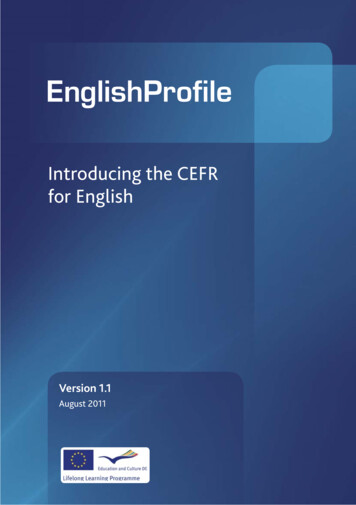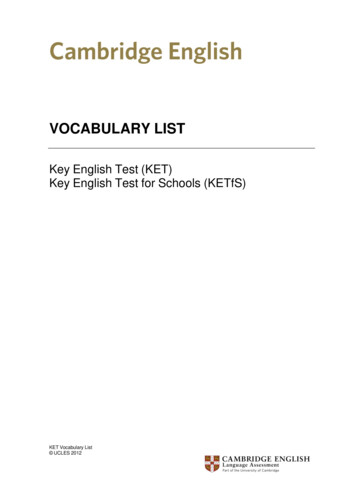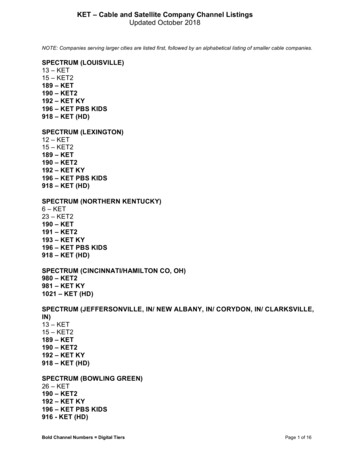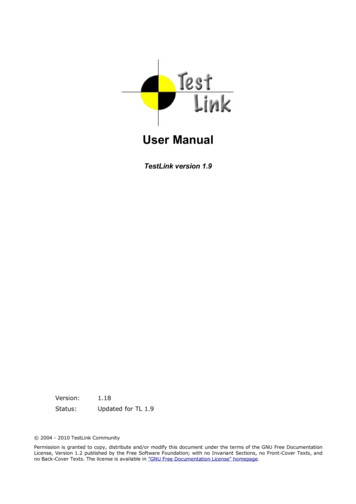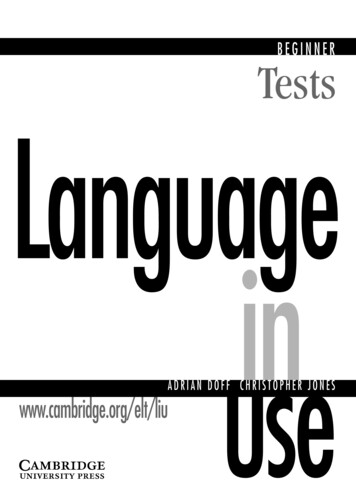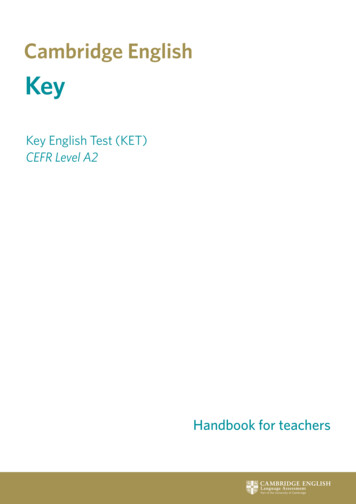
Transcription
KeyKey English Test (KET)CEFR Level A2Handbook for teachers
Content and overviewPaper/timingContentTest focus1Nine parts:Five parts (Parts 1–5) test a range of reading skills with avariety of texts, ranging from very short notices to longercontinuous texts.Parts 6–9 concentrate on testing basic writing skills.Assessment of candidates’ ability to understandthe meaning of written English at word, phrase,sentence, paragraph and whole text level.Five parts ranging from short exchanges to longer dialoguesand monologues.Assessment of candidates’ ability to understanddialogues and monologues in both informal andneutral settings on a range of everyday topics.Two parts:in Part 1, candidates interact with an examiner;in Part 2, they interact with another candidate.Assessment of candidates’ ability to answerquestions about themselves and to ask/answerquestions about factual non-personal information.READING &WRITING1 hour 10 minutes2LISTENINGAssessment of candidates’ ability to producesimple written English, ranging from one-wordanswers to short pieces of continuous text.Approx. 30 minutes(including 8 minutestransfer time)3SPEAKING8–10 minutes perpair of candidates
CONTENTSPrefaceThis handbook is for teachers who are preparing candidates for Cambridge English: Key, also known as Key English Test (KET). The introductiongives an overview of the exam and its place within the range of Cambridge English exams. This is followed by a focus on each paper andincludes content, advice on preparation and example papers.If you need further copies of this handbook, please email marketingsupport@cambridgeenglish.orgContentsAbout Cambridge English Language Assessment 2The world’s most valuable range of English qualifications 2Paper 2 Listening 22General description 22Key features of Cambridge English exams 2Structure and tasks 22Proven quality 2Preparation 23Cambridge English: Key – an overview 3Who is the exam for? 3Who recognises the exam? 3What level is the exam? 3Exam content and processing 3A thorough test of all areas of language ability 3Language specifications 4International English 6Marks and results 6Sample paper 24Answer key and candidate answer sheet 29Paper 3 Speaking 30General description 30Structure and tasks 30Preparation 31Sample materials 32Assessment 33Cambridge English: Key Glossary 38Certificates 6Exam support 7Support for teachers 7Support for candidates 7Paper 1 Reading and Writing 9General description 9Structure and tasks 9Preparation 11Sample paper 13Answer key 19Assessment of Writing Part 9 20Sample answers with examiner comments 20Candidate answer sheet 21CAMBRIDGE ENGLISH: KEY HANDBOOK FOR TEACHERS1
ABOUT CAMBRIDGE ENGLISH LANGUAGE ASSESSMENTAbout Cambridge EnglishLanguage Assessmentapproach of the Common European Framework of Reference forLanguages (CEFR).Cambridge English: Key is developed by Cambridge English LanguageAssessment, part of the University of Cambridge.We are one of three major exam boards which form the CambridgeAssessment Group (Cambridge Assessment). More than 8 millionCambridge Assessment exams are taken in over 160 countriesaround the world every year.One of the oldest universities in the worldand one of the largest in the United KingdomDepartments of the UniversityTo find out more about Cambridge English exams and the CEFR, go towww.cambridgeenglish.org/cefrIn addition to our own programmes of world-leading research, wework closely with professional bodies, industry professionals andgovernments to ensure that our exams remain fair and relevant tocandidates of all backgrounds and to a wide range of stakeholders.Key features of Cambridge English examsCambridge English exams: Cambridge Assessment: the trading name for theUniversity of Cambridge Local Examinations Syndicate (UCLES) Departments (exam boards) Cambridge English LanguageAssessmentProvider of the world’s mostvaluable range of qualifications forlearners and teachers of EnglishCambridge InternationalExaminationsThe world’s largest provider ofinternational education programmesand qualifications for 5–19-year-oldsOCR: Oxford Cambridge and RSAExaminationsOxford Cambridge and RSAOne of the UK’s leading providersof qualificationsThe world’s most valuable range of EnglishqualificationsCambridge English Language Assessment offers the world’s leadingrange of qualifications for learners and teachers of English. Over5 million Cambridge English exams are taken each year in more than130 countries.We offer assessments across the full spectrum of language ability.We provide examinations for general communication, for professionaland academic purposes, and also specialist legal and financial Englishqualifications. All of our exams are aligned to the principles and2CAMBRIDGE ENGLISH: KEY HANDBOOK FOR TEACHERSare based on realistic tasks and situations so that preparing fortheir exam gives learners real-life language skillsaccurately and consistently test all four language skills – reading,writing, listening and speaking – as well as knowledge of languagestructure and its useencourage positive learning experiences, and seek to achieve apositive impact on teaching wherever possibleare as fair as possible to all candidates, whatever their national,ethnic and linguistic background, gender or disability.Proven qualityOur commitment to providing exams of the highest possible quality isunderpinned by an extensive programme of research and evaluation,and by continuous monitoring of the marking and grading of allCambridge English exams. Of particular importance are the rigorousprocedures which are used in the production and pretesting ofquestion papers.All our systems and processes for designing, developing anddelivering exams and assessment services are certified as meetingthe internationally recognised ISO 9001:2008 standard for qualitymanagement and are designed around five essential principles:Validity – are our exams an authentic test of real-life English?Reliability – do our exams behave consistently and fairly?Impact – does our assessment have a positive effect on teachingand learning?Practicality – does our assessment meet learners’ needs withinavailable resources?Quality – how we plan, deliver and check that we provideexcellence in all of these fields.How these qualities are brought together is outlined in ourpublication Principles of Good Practice, which can be downloaded freefrom www.cambridgeenglish.org/principles
CAMBRIDGE ENGLISH: KEY – AN OVERVIEWCambridge English: Key –an overviewCambridge English: Key is a qualification at pre-intermediate level.It demonstrates that a person can use English to communicate insimple situations and has achieved a good foundation in learningEnglish.Candidates can choose to take Cambridge English: Key as either apaper-based or computer-based exam.Examples of Can Do statements at Level A2TypicalabilitiesReading and WritingListening and SpeakingOverallgeneralabilityCAN understand straightforwardinformation within a known area.CAN understand simple questionsand instructions.CAN complete forms and writeshort, simple letters or postcardsrelated to personal information.CAN express simple opinions orrequirements in a familiar context.Social &TouristCAN understand straightforwardinformation on food, standardmenus, road signs and messageson automatic cash machines.CAN understand straightforwarddirections, provided that these arenot lengthy or complex.Cambridge English: Key for Schools, a version of Cambridge English: Keywith exam content and topics targeted at the interests andexperience of school-age learners, is also available.Who is the exam for?CAN complete most forms relatedto personal information.WorkCambridge English: Key is aimed at learners who want to: understand and use basic phrases and expressionsintroduce themselves and answer basic questions about personaldetailsinteract with English speakers who talk slowly and clearlywrite short, simple notes.Who recognises the exam? Cambridge English: Key is a truly international certificate,recognised around the world for business and study purposes.Employers, universities and government departments officiallyrecognise Cambridge English: Key as a basic qualification inEnglish.The exam is accredited by Ofqual, the statutory regulatoryauthority for external qualifications in England, and itscounterparts in Wales and Northern Ireland.For more information about recognition go towww.cambridgeenglish.org/recognitionWhat level is the exam?Cambridge English: Key is targeted at Level A2 of the CEFR. Achievinga certificate at this level proves that a person can use English tocommunicate in simple situations.What can candidates do at Level A2?The Association of Language Testers in Europe (ALTE) has carriedout research to determine what language learners can typically do ateach CEFR level. It has described these abilities in a series of Can Dostatements using examples taken from real-life situations.Cambridge English Language Assessment, as one of the foundingmembers of ALTE, uses this framework as a way of ensuring itsexams reflect real-life language skills.CAN understand most shortreports or manuals of a predictablenature within his/her own area ofexpertise.CAN write a short, comprehensiblenote of request to a colleagueor a known contact in anothercompany.StudyCAN express likes and dislikesin familiar contexts using simplelanguage.CAN understand the generalmeaning of a presentation madeat a conference if the language issimple and backed up by visualsor video.CAN state simple requirementswithin own job area.CAN understand the generalmeaning of a simplified textbookor article, reading very slowly.CAN understand basic instructionson class time, dates and roomnumbers.CAN write a very short, simplenarrative or description.CAN express simple opinions usingexpressions such as ‘I don’t agree’.Exam content and processingCambridge English: Key is a rigorous and thorough test of English atLevel A2. It covers all four language skills – reading, writing, listeningand speaking. Preparing for Cambridge English: Key helps candidatesdevelop the skills they need to use English to communicate effectivelyin a variety of practical contexts.A thorough test of all areas of language abilityThere are three papers: Reading and Writing, Listening and Speaking.The Reading and Writing paper carries 50% of the total marks, theListening paper and the Speaking paper each carry 25% of the totalmarks. Detailed information on each test and sample papers followlater in this handbook, but the overall focus of each test is as follows:Reading and Writing: 1 hour 10 minutesCandidates need to be able to understand simple written information such as signs,brochures, newspapers and magazines. They must also be able to produce simple writtenEnglish.Listening: 30 minutes (approximately)Candidates need to be able to understand announcements and other spoken materialwhen people speak reasonably slowly.Speaking: up to 10 minutesCandidates take the Speaking test with another candidate or in a group of three, and aretested on their ability to take part in different types of interaction: with the examiner, withthe other candidate and by themselves.CAMBRIDGE ENGLISH: KEY HANDBOOK FOR TEACHERS3
EXAM CONTENT AND PROCESSINGEach of these three test components provides a unique contributionto a profile of overall communicative language ability that defineswhat a candidate can do at this level.Language specificationsCandidates who are successful in Cambridge English: Key should beable to satisfy their basic communicative needs in a range of everydaysituations with both native and non-native speakers of English.The following is a summary of the language which is tested inCambridge English: Key. In terms of vocabulary and grammaticalstructure, Cambridge English: Key candidates will have productivecontrol of only the simplest of exponents for each category below;there is a wider, but still limited, range that they will be able to dealwith receptively; and they will have strategies for coping with theunfamiliar.Language purposes Carrying out certain transactions:making arrangementsmaking purchasesordering food and drink Giving and obtaining factual information:personalnon-personal (places, times, etc.) Establishing and maintaining social and professional contacts:meeting peopleextending and receiving invitationsproposing/arranging a course of actionexchanging information, views, feelings and wishes.Language functionsThere are six broad categories of language functions (what people doby means of language): Imparting and seeking factual informationExpressing and finding out attitudesGetting things doneSocialisingStructuring discourseCommunication repair.A more detailed inventory of functions, notions and grammaticalareas covered by Cambridge English: Key is given below.Inventory of functions, notions and communicative tasksThe realisations of these functions, notions and communicative tasks willbe in the simplest possible ways.greeting people and responding to greetings (in person and on thephone)introducing oneself and other peopleasking for and giving personal details: (full) name, age, address,names of relatives and friends, occupation, etc.understanding and completing forms giving personal detailsdescribing education and/or jobdescribing people (personal appearance, qualities)asking and answering questions about personal possessionsasking for repetition and clarificationrestating what has been saidchecking on meaning and intentionhelping others to express their ideas4CAMBRIDGE ENGLISH: KEY HANDBOOK FOR TEACHERSinterrupting a conversationasking for and giving the spelling and meaning of wordscounting and using numbersasking and telling people the time, day and/or dateasking for and giving information about routines and habitsunderstanding and giving information about everyday activitiestalking about what people are doing at the momenttalking about past events and states in the past, recent activities andcompleted actionsunderstanding and producing simple narrativesreporting what people saytalking about future situationstalking about future plans or intentionsmaking predictionsidentifying and describing accommodation (houses, flats, rooms,furniture, etc.)buying and selling things (costs and amounts)talking about food and ordering mealstalking about the weathertalking about one’s healthfollowing and giving simple instructionsunderstanding simple signs and noticesasking the way and giving directionsasking for and giving travel informationasking for and giving simple information about placesidentifying and describing simple objects (shape, size, weight, colour,purpose or use, etc.)making comparisons and expressing degrees of differenceexpressing purpose, cause and result, and giving reasonsmaking and granting/refusing simple requestsmaking and responding to offers and suggestionsexpressing and responding to thanksgiving and responding to invitationsgiving advicegiving warnings and stating prohibitionsasking/telling people to do somethingexpressing obligation and lack of obligationasking and giving/refusing permission to do somethingmaking and responding to apologies and excusesexpressing agreement and disagreement, and contradicting peoplepaying complimentssympathisingexpressing preferences, likes and dislikes (especially about hobbiesand leisure activities)talking about feelingsexpressing opinions and making choicesexpressing needs and wantsexpressing (in)ability in the present and in the pasttalking about (im)probability and (im)possibilityexpressing degrees of certainty and doubtInventory of grammatical areasVerbsRegular and irregular formsModalscan (ability; requests; permission)could (ability; polite requests)would (polite requests)will (future)
EXAM CONTENT AND PROCESSINGshall (suggestion; offer)should (advice)may (possibility)have (got) to (obligation)must (obligation)mustn’t (prohibition)need (necessity)needn’t (lack of necessity)TensesPresent simple: states, habits, systems and processes (and verbs notused in the continuous form)Present continuous: present actions and future meaningPresent perfect simple: recent past with just; indefinite past with yet,already, never, ever; unfinished past with for and sincePast simple: past eventsPast continuous: parallel past actions, continuous actions interruptedby the past simple tenseFuture with going toFuture with will and shall: offers, promises, predictions, etc.Verb formsAffirmative, interrogative, negativeImperativesInfinitives (with and without to) after verbs and adjectivesGerunds (-ing form) after verbs and prepositionsGerunds as subjects and objectsPassive forms: present and past simpleShort questions (Can you?) and answers (No, he doesn’t)Clause typesMain clause: Carlos is Spanish.Co-ordinate clause: Carlos is Spanish and his wife is English.Subordinate clause following sure, certain: I’m sure (that) she’s adoctor.Subordinate clause following know, think, believe, hope:I hope you’re well.Subordinate clause following say, tell: She says (that) she’s his sister.Subordinate clause following if, when, where, because:I’ll leave if you do that again.He’ll come when you call.He’ll follow where you go.I came because you asked me.InterrogativesWhat; What ( noun)Where; WhenWho; Whose; WhichHow; How much; How many; How often; How long; etc.Why(including the interrogative forms of all tenses and modals listed)NounsSingular and plural (regular and irregular forms)Countable and uncountable nouns with some and anyAbstract nounsCompound nounsNoun phrasesGenitive: ‘s & s’Double genitive: a friend of theirsPronounsPersonal (subject, object, possessive)Impersonal: it, thereDemonstrative: this, that, these, thoseQuantitative: one, something, everybody, etc.Indefinite: some, any, something, one, etc.Relative: who, which, thatDeterminersa countable nounsthe countable/uncountable nounsAdjectivesColour, size, shape, quality, nationalityPredicative and attributiveCardinal and ordinal numbersPossessive: my, your, his, her, etc.Demonstrative: this, that, these, thoseQuantitative: some, any, many, much, a few, a lot of, all, other,every, etc.Comparative and superlative forms (regular and irregular)Order of adjectivesParticiples as adjectivesAdverbsRegular and irregular formsManner: quickly, carefully, etc.Frequency: often, never, twice a day, etc.Definite time: now, last week, etc.Indefinite time: already, just, yet, etc.Degree: very, too, rather, etc.Place: here, there, etc.Direction: left, right, etc.Sequence: first, next, etc.Pre-verbal, post-verbal and end-position adverbsComparative and superlative forms (regular and irregular)PrepositionsLocation: to, on, inside, next to, at (home), etc.Time: at, on, in, during, etc.Direction: to, into, out of, from, etc.Instrument: by, withMiscellaneous: like, about, etc.Prepositional phrases: at the end of, in front of, etc.Prepositions preceding nouns and adjectives: by car, for sale, onholiday, etc.Connectivesand, but, or,when, where, because, ifNote that students will meet forms other than those listed above inCambridge English: Key, on which they will not be directly tested.TopicsClothesDaily lifeEntertainment and mediaFood and drinkHealth, medicine and exerciseHobbies and leisureHouse and homeLanguagePeoplePersonal feelings, opinions and experiencesPersonal identificationPlaces and buildingsCAMBRIDGE ENGLISH: KEY HANDBOOK FOR TEACHERS5
EXAM CONTENT AND PROCESSINGSchool and studyServicesShoppingSocial interactionSportThe natural worldTransportTravel and holidaysWeatherWork and jobsCertificatesWe have made enhancements to the way we report the results of ourexams because we believe it is important to recognise candidates’achievements.The Common EuropeanFramework of ReferenceCProficientuserLexisBIndependentuserThe Cambridge English: Key Vocabulary List includes items whichnormally occur in the everyday vocabulary of native speakers usingEnglish today.A list of vocabulary that may appear in the CambridgeEnglish: Key examination is available on our he Vocabulary List does not include all the words which couldappear in Cambridge English: Key question papers and candidatesshould not confine their study of vocabulary to the list alone.C2C1B2B1Pass with Distinction*A2ABasic userCandidates should know the lexis appropriate to their personalrequirements, for example, nationalities, hobbies, likes and dislikes.Note that the use of American pronunciation, spelling and lexis isacceptable in Cambridge English: Key.Cambridge English:KeyPass with MeritPass.A great first stepin communicatingin English.A1Level A1.* Pass with Distinction wasintroduced in September 2011Cambridge English: Key – Level B1Pass with DistinctionExceptional candidates sometimes show ability beyond Level A2. Ifa candidate achieves a Pass with Distinction, they will receive theKey English Test certificate stating that they demonstrated ability atLevel B1.Cambridge English: Key – Level A2International EnglishIf a candidate achieves Pass with Merit or Pass in the exam, they willbe awarded the Key English Test certificate at Level A2.English is used in a wide range of international contexts. To reflectthis, candidates’ responses to tasks in Cambridge English exams areacceptable in all varieties and accents of English, provided they donot interfere with communication. Materials used feature a range ofaccents and texts from English-speaking countries, including the UK,North America and Australia. US and other versions of spelling areaccepted if used consistently.If a candidate’s performance is below Level A2, but falls within LevelA1, they will receive a Cambridge English certificate stating that theydemonstrated ability at A1 level.Marks and resultsCambridge English: Key gives detailed, meaningful results. Allcandidates receive a Statement of Results. Candidates whoseperformance ranges between CEFR Levels A1 and B1 also receivea certificate.Statement of ResultsThis Statement of Results outlines: the candidate’s result. This is based on a candidate’s total score inall three papersa graphical display of a candidate’s performance in each paper(shown against the scale Exceptional – Good – Borderline –Weak)a standardised score out of 100 which allows a candidate to seeexactly how they performed.Level A1 CertificateSpecial circumstancesCambridge English exams are designed to be fair to all test takers.This commitment to fairness covers: Special arrangementsThese are available for candidates with a permanent orlong‑term disability. Consult the Centre Exams Manager (CEM)in your area for more details as soon as you become aware of acandidate who may need special arrangements. Special considerationWe will give special consideration to candidates affectedby adverse circumstances such as illness or bereavementimmediately before or during an exam. Applications for specialconsideration must be made through the centre no later than10 working days after the exam date. MalpracticeWe will investigate all cases where candidates are suspected ofcopying, collusion or breaking the exam regulations in some otherway. Results may be withheld while they are being investigated,or because we have found an infringement of regulations. Centresare notified if a candidate’s results have been investigated.For more information about special circumstances go towww.cambridgeenglish.org/help6CAMBRIDGE ENGLISH: KEY HANDBOOK FOR TEACHERS
EXAM SUPPORTExam supportSupport for candidatesCambridge English websiteOfficial Cambridge English exam preparation materialsTo support teachers and help learners prepare for their exams,Cambridge English Language Assessment and Cambridge UniversityPress have developed a range of official support materials includingcoursebooks and practice tests. These official materials are availablein both print and digital formats.We provide learners with a wealth of exam resources and preparationmaterials throughout our main website, including exam advice,sample papers and a guide for glish.org/prepareSupport for teachersOur website provides an invaluable, user-friendly, free resource for allteachers preparing for our exams. It includes:General information – handbooks for teachers and samplepapersDetailed information – format, timing, number of questions, tasktypes, mark scheme of each paperAdvice for teachers – developing students’ skills and preparingthem for the examDownloadable lessons – a lesson for every part of every paperTeaching qualifications – the whole range of Cambridge EnglishTeaching QualificationsSeminars and webinars – a wide range of exam-specific seminarsand live and recorded webinars for new and ing-englishFacebookStudents can also join our active Facebook community to get tips onEnglish language learning and take part in fun and topical quizzes.www.facebook.com/CambridgeEnglishExam sessionsCambridge English: Key is available as a paper-based orcomputer‑based test. Candidates must be entered throughan authorised Cambridge English Language Assessmentexamination centre. Find your nearest centre atwww.cambridgeenglish.org/centresearchFurther informationContact your local authorised exam centre, or our helpdesk(www.cambridgeenglish.org/help) for: copies of the regulationsdetails of entry procedureexam datescurrent feesmore information about Cambridge English: Key and otherCambridge English exams.Cambridge English TeacherCambridge English Teacher is the professional membershipthat supports teaching excellence. It offers teachers continuousprofessional development that is both reliable and convenient.It includes online courses, access to ELT experts and otherprofessionals, sharing best practice and networking. Everything isonline, so is available anytime, anywhere. Cambridge English Teacheris provided by Cambridge University Press and Cambridge EnglishLanguage Assessment, world leaders in English language teachingand assessment. Join as a teacher, or find out about InstitutionalMembership at www.cambridgeenglishteacher.orgCAMBRIDGE ENGLISH: KEY HANDBOOK FOR TEACHERS7
8CAMBRIDGE ENGLISH: KEY HANDBOOK FOR TEACHERS
Paper 1Reading and WritingGeneral descriptionPAPER FORMATTIMINGNO. OF QUESTIONSTASK TYPESSOURCESANSWERINGMARKSThis paper contains nine parts.1 hour 10 minutes.56Matching, multiple choice,multiple‑choice cloze, open cloze,word completion, informationtransfer and guided writing.Authentic and adapted-authenticreal-world notices, newspaperand magazine articles, simplifiedencyclopaedia entries.Candidates indicate answers eitherby shading lozenges (Parts 1–5) orwriting answers (Parts 6–9) on theanswer sheet.Each item carries one mark, exceptfor question 56 which is marked outof 5. This gives a total of 60 marks,which is weighted to a final markout of 50, representing 50% of totalmarks for the whole examination.Structure and tasksPART 1TASK TYPEAND FORMATTASK FOCUSNO. OF QSMatching.Matching five prompt sentences to eightnotices, plus one example.Gist understanding of real-world notices.Reading for main message.5PART 2TASK TYPEAND FORMATTASK FOCUSNO. OF QSThree-option multiple-choice sentences.Five sentences (plus an integrated example)with connecting link of topic or story line.Reading and identifying appropriatevocabulary.5PART 3TASK TYPEAND FORMATTASK FOCUSNO. OF QSThree-option multiple choice.Five discrete 3-option multiple-choiceitems (plus an example) focusing on verbalexchange patterns.ANDMatching.Five matching items (plus an integratedexample) in a continuous dialogue, selectingfrom eight possible responses.Functional language. Reading and identifyingappropriate response.10PART 4TASK TYPEAND FORMATTASK FOCUSNO. OF QSRight/Wrong/Doesn’t say ORThree-option multiple choice.One long text or three short texts adaptedfrom authentic newspaper and magazinearticles.Seven 3-option multiple-choice items orseven Right/Wrong/Doesn’t say items, plusan integrated example.Reading for detailed understanding and mainidea(s).7CAMBRIDGE ENGLISH: KEY HANDBOOK FOR TEACHERS9
Paper 1Reading and WritingStructure and tasksPART 8TASK TYPEAND FORMATPART 5TASK TYPEAND FORMATTASK FOCUSNO. OF QSMultiple-choice cloze.A text adapted from an original source, forexample encyclopaedia entries, newspaperand magazine articles.Eight 3-option multiple-choice items, plus anintegrated example.Reading and identifying appropriatestructural word (auxiliary verbs, modalverbs, determiners, pronouns, prepositions,conjunctions etc.).8PART 6TASK TYPEAND FORMATTASK FOCUSNO. OF QSWord completion.Five dictionary definition type sentences(plus an integrated example).Five words to identify and spell.Reading and identifying appropriate lexicalitem, and spelling.5PART 7TASK TYPEAND FORMATTASK FOCUSNO. OF QS10Open cloze.Text of type candidates could be expected towrite, for example a short letter or email.Ten spaces to fill with one word (plus anintegrated example) which must be spelledcorrectly.Reading and identifying appropriate wordwith focus on structure and/or lexis.10CAMBRIDGE ENGLISH: KEY HANDBOOK FOR TEACHERSTASK FOCUSNO. OF QSInformation transfer.One or two short input texts, authenticin nature (notes, adverts etc.) to promptcompletion of an output text (form, note,etc.).Five spaces to fill on output text with one ormore words or numbers (plus an integratedexample).Reading and writing down appropriatewords or numbers with focus on content andaccuracy.5PART 9TASK TYPEAND FORMATTASK FOCUSNO. OF QSGuided writing.Either a short input text or rubric to prompt awritten response.Three messages to communicate.Writing a short note, email or postcard of25–35 words.1
PAPER 1: READING AND WRITING PREPARATIONPreparationPART 2 General The Reading and Writing part of the test takes 1 hour and10 minutes with a total of 56 questions. Candidates have aquestion paper and a s
Cambridge English Language Assessment offers the world’s leading range of qualifications for learners and teachers of English. Over 5 million Cambridge English exams are taken each year in more than 130 countries. We offer assessments across the full spectrum of language ability. We provide
